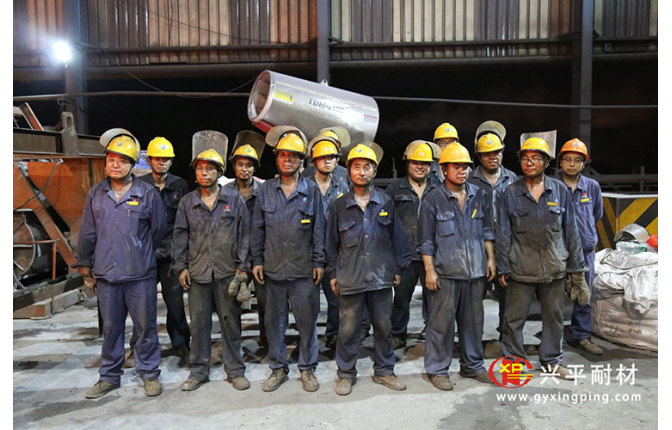目前对于铁沟内部整体浇筑,我公司研制的高炉出铁场铁沟用铝碳化硅碳质浇注料采用优质的致密刚玉、棕刚玉、铝矾土、碳化硅及碳素材料为主要原材料,添加多种有机和无机结合剂及外加剂配制而成。使用时只需加入一定量的水,在搅拌机里搅拌后即可进行浇注。该类浇注料具有凝结时间快,耐铁水和熔渣的侵蚀和冲刷能力强,抗热震性好,重烧体积变化小,不沾渣铁,抗氧化能力强,施工容易,使用寿命长等特点。高炉出铁场铁沟内部用浇注料主要分为出铁主沟、落铁点、支沟、渣沟、撇渣器、摆动流嘴工作衬浇注料。
施工工艺
1.施工前准备
a、将各种型号袋装浇注料施工前及时运到现场,按牌号堆放,作好标记,且防雨、防水、防潮。
b、将准备好的挖机(含挖斗、炮锤、快速连接器)、模具、搅拌机、自动布料小车、插入式振动棒、风镐等施工工具及其连接件和配件在施工前及时运到现场、接好电源,进行调试。
c.施工人员提前一天进行安全培训,到现场熟悉现场情况,明确各自的分工与责任。
2.残沟的拆除
a、主沟:用炮机拆除,必须由专人用激光灯指挥,控制拆除量,原则上把变质层及松散料拆除即可,局部人工用风镐进行修理。拆除完毕后用挖机将拆除废料清理到沟外并用高压风管将沟内残存粉状或小颗粒状废料吹到沟外,使沟内拆除废料全部清理干净。
拆除标准:沟底将残铁、残渣拆除、清理干净即可;沟壁凡变白、变灰的变质料全部拆除;沟壁的疏松料全部拆除;尤其是落铁点部位,必须保持拆除到位,不得马虎。
b、支沟、渣沟:炮机清理渣铁之后,原则上人工拆除,拆除标准同主沟。
c、摆动溜槽:人工拆除,拆除标准同主沟。
残沟拆除时,注意安全,防止烫伤。
3.浇筑前准备工作
a.混料前清理、冲洗搅拌机、布料小车及其他全部施工工具,并将搅拌机和自动布料车电源接好。
b.在模具侧面涂上适量脱模油,将圆钢管插入模具上部预留原孔内,然后将磨具单独吊入再拼接或拼接好再吊入已清理好的主沟或支沟、或渣沟、或摆动沟内,用钢筋将圆钢管和钢壳上部边缘的钢板焊接在一起,以确保在施工过程不活动、不上浮。
c.磨具拼接完成后,在磨具上面放道轨并进行固定,将清理好的搅拌机放在轨道的一端,并将自动布料车放在轨道上,然后便可进行加料搅拌浇注。
4.浇注操作方法
a、新建高炉的新沟,浇注前应清除沟内杂物,并把永久衬砖用水润湿。
b、将袋装铁沟料放入搅拌机内,干混1-2分钟,然后再按要求加入洁净自来水。
耐火浇注料加水量
料种 | 加水量% |
落铁点浇注料(XPTG-N1) | 5.0—6.0 |
主沟浇注料(XPTG-N2) | 5.5—6.0 |
支渣沟浇注料(XPTG-N3,N4) | 6.0—6.5 |
摆动沟浇注料(XPTG-N5) | 5.5—6.0 |
现场使用时,可根据实际情况酌量增减,湿混4-5分钟即可出料。
c、含水量的判断:取搅拌料用手捏成一个紧密的球团,直径为7.5—10cm,将此球团抛高约30cm,然后用手接住,如果球团变形而未碎,表示含水量正好;如果球团变形并从手缝中流出,则表示含水量过多;如果球团开裂散落,则表示含水量太少。由于含水量(水灰比)的大小,直接影响浇注料的质量,因此,在满足施工要求的条件下,以尽量减少用水量为宜。
d、将搅拌好的浇注料放入模具外的沟内进行浇注振动。当用振动棒时,铺料厚度不应超过振动棒作用部分长度的1.25倍,振动棒要慢慢插入浇注料中,待浇注料表面泛浆呈流动状态时再移动振动棒,移动速度为1-2米/分,振动棒的移动间距不应大于作用半径的1.5倍(作用半径一般为20cm左右),振动棒拔出时速度要慢,当棒头接近表面时,应停留数秒钟,以使表面平整,振动棒在每一位置上的振动延续时间不宜太长,否则易产生离析,一般控制在4-5分钟内为宜。
e、浇注施工必须连续进行,在前层浇注料凝结前,应将次层浇注料浇注完毕。特殊情况,如搅拌机故障或天车故障等,间隔超过凝结时间,应将已浇好的料表面划成麻面,并在表面覆盖塑料薄膜,以保持湿润,为后续浇注做准备。
f、浇注料施工后,2-4小时即可脱模,自然养护12-24小时后即可进行小火烘烤。特殊情况,红沟浇注时,30分钟左右即可脱膜。
g、拆模时要注意不可损坏棱角及表面。
h、烘烤是耐火浇注料使用效果好坏的关键环节,其作用主要是排除浇注料的游离水及化学结合水,烘烤得当,可以提高铁沟浇注料的使用寿命。否则,水分排除不畅通,可使浇注料体产生裂纹、剥落,甚至引起爆裂事故。烘烤一般采用柴火烘烤和煤气管烘烤两种方式。
I、烘烤时如用煤气喷火管,煤气喷火管(烘烤器)用Φ50长6m的钢管,四周钻有喷火孔Φ3。烘烤器放入主沟底时,应以耐火砖垫起,不得直接放在沟底部。开始用小火似点灯,烘24小时后再用大火加压缩空气直接用煤气管喷吹,瞬即将喷咀前方沟衬烧红,如此烘烤72小时。每个施工现场,根据实际情况而定。
5.烘烤曲线
主沟、铁沟、渣铁工作衬快干浇注料
| 点火形式 | 温度范围(℃) | 所需时间(h) |
| 小火 | <300 | 24 |
| 中火 | <600 | 36 |
| 大火 | >600 | 36 |
上述烘烤温度曲线是基建新沟。生产周期的铁沟视用户要求和生产节奏而定。

 18538276310
18538276310
 中文版
中文版 ENGLISH
ENGLISH
 Classify:
Classify: 2019-08-24
2019-08-24



















